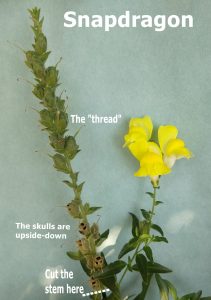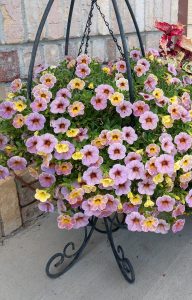Returning to this year’s theme of how various flowers got their names, this month I’ll be sharing information about Impatiens.

The word “impatiens” is Latin and, somewhat obviously, it means “impatient.” These plants were named for their explosive seed-pods which propel seeds in every direction when ripe. The seed pods look very much like flower buds although they turn slightly brown when ripe (circled in the picture). When touched they will explode – a curiosity and amusement to both children and adults!
There are over 850 known species of Impatiens. They are native and grow as perennials in mountainous areas of Asia and Africa.
The most common annual Impatiens in our area are Impatiens walleriana which was named in honor of Rev. Horace Waller, who was a missionary in central Africa in the 1800’s.
New Guinea Impatiens (Impatiens hawkerii) are indeed native to New Guinea. This species often have darker colored leaves and bigger flowers – 2 to 2.5” diameter. They were collected by the USDA in the early 1970’s. Only 25 plants were collected from New Guinea and from those 25 plants we now have a multitude of colors and plants available at the garden centers.
Impatiens grow easily from seed or stem cuttings. When Impatiens are labeled which a specific color, such as “Super Elfin Lipstick,” they were grown from stem cuttings. When Impatiens are grown from seed, the flower color can be anything – except yellow or blue.
Other common names for Impatiens are Busy Lizzy (for the abundance of flowers), Touch-me-not (for the exploding seedpods) and Patient Lucy (perhaps for their shade tolerance).
Whatever you want to call them, Impatiens are well loved garden and container plants for their ever-blooming, cheerful habit.
Caring for your Impatiens
- Impatiens require moist soil and prefer shady locations.
- Impatiens are wonderful easy-care plants and do not require deadheading (removing spent blooms). They occasionally get somewhat leggy and need to be cut back.
- New Guinea Impatiens prefer a filtered sunlight with a few hours of direct sunlight if possible.
- The “Sunpatiens” cultivar of New Guinea Impatiens can grow in full sun.
- Impatiens are not tolerant of even the slightest frost in the fall although covering them with a frost fabric may help to protect them.
Resources:
Ellis, Barbara W. “Impatiens.” Taylor’s Guide to Annuals: How to Select and Grow More than 400 Annuals, Biennials, and Tender Perennials. Boston: Houghton Mifflin, 1999. 307-09. Print.
Pitman, Derick. “Hybrid Impatiens.” Mr Impatiens – Home Page. Web. 23 June 2011. .
Wells, Diana. “Impatiens.” 100 Flowers and How They Got Their Names. Chapel Hill: Algonquin of Chapel Hill, 1997. 102-03. Print.



